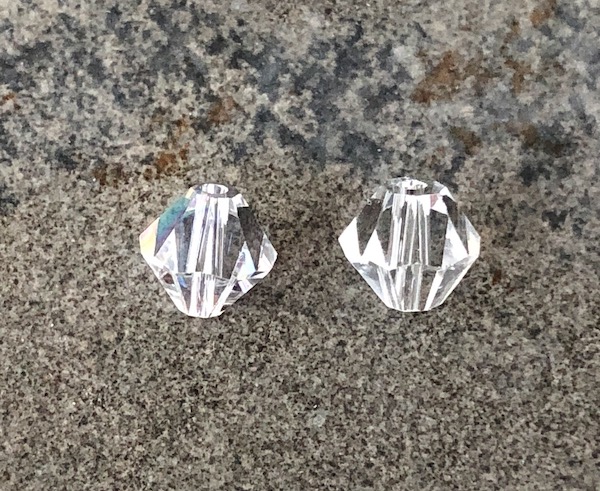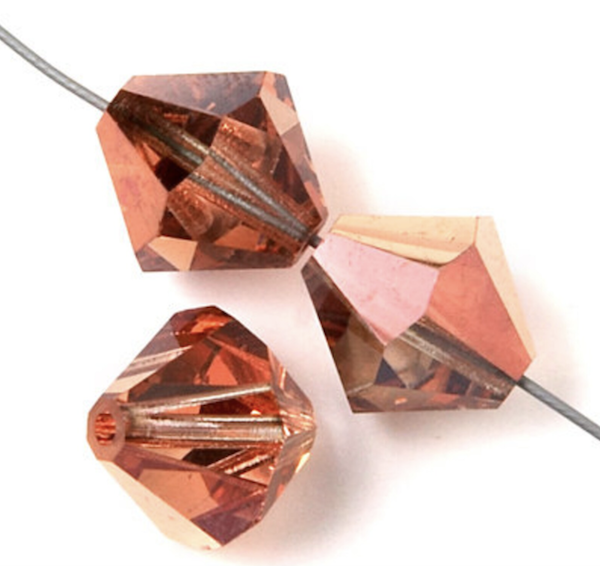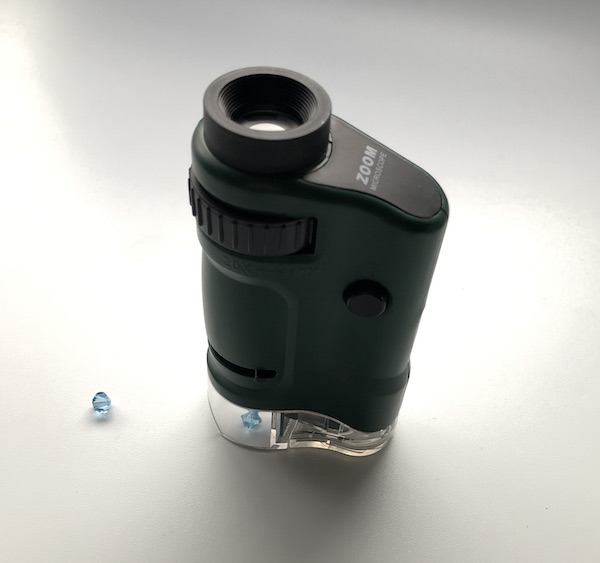Many jewelry makers are still reeling from the large scale, but not, complete withdrawal of Swarvoski from the DIY marketplace. My original post written almost a year ago - Is Swarovski Going to Stop Making Crystal Beads? What are the Alternatives? - is still strongly trending on Google searches.
I am not surprised as the loss of these finely made crystals is a big blow to a lot of us.
In that older post, I shared a photo I took with my iPhone which shows the difference between Chinese and Swarovski crystals.
 |
| Swarovski crystal (AB coating) vs Chinese crystal (iPhone photography) |
But to really see the difference in glass quality, we need increased magnification. Thanks to Karin Vail of bkvail on Etsy, who cleverly thought to photograph Swarovski, Preciosa and Chinese made 4 mm bicone crystals in a lab under a microscope. Alison Griffiths of Argus Collection tipped me off about Karin's photos and Karin graciously allowed me to post them here. (Updated)
Bear in mind, only single samples were photographed. So we have to assume all 4 mm bicones are similar in quality from each manufacturer. This is the reason why scientists sample more than one specimen in case an odd one out is accidentally picked from the batch.
Under greater magnification, the Swarovski 4 mm bicone showed great clarity with few flaws in the glass - little bubbles etc. The precision faceting in terms of proportion and symmetry is what makes their crystals so sought after. The facets reflect and transmit light through the crystal and thus increases the bicones brilliance.
Swarovski has managed to produce Advanced lead-free crystals while still maintaining the sparkle we all love from their original lines.
| Swarvoski 4 mm bicone |
It was more difficult to directly compare the Swarovski to the Preciosa and Chinese made bicones because the latter two are AB crystals, not clear like the Swarovski.
You can see some bubbles and tiny scratches in the Preciosa. Are these machining flaws or small areas where the AB coating has come off here and there? Or due to rough handling in storage? I don't know because we do not have a photograph of a Swarovski AB under the same microscope.
But what is noticeable is the Preciosa bicone's hole area is not flat like that of the Swarovski above. This may affect how seed beads sit against the bicones. So patterns will need to be checked when shifting to Preciosa bicones.
| Preciosa 4 mm bicone |
I found the Preciosa crystal image confusing. Looking at this Etsy listing for 3 mm Preciosa bicones, the hole area is clearly flat. So was the above crystal made a while ago? If so, Preciosa machining looks like it has most likely improved. This Czech brand stands to gain the most with Swarovski's move to largely withdraw from the DIY market.
The microscopic photo of the Chinese crystal AB specimen exhibited the same tiny flaws as the above but in addition did show unpolished spots in the form of dents. The hole area was flat and also unpolished. This could contribute to greater wear and tear on beading threads.
The reason why I say this is based on my personal experience with Chinese crystals. The ones I have were purchased from the Canadian wholesaler, MacDonaldWang. The business is owned by a husband and wife team whom I have personally met on a number of occasions, including at their Toronto warehouse. The wife is originally from China. As the chief buyer and native Mandarin speaker, she makes frequent trips (before Covid) to many Chinese factories so she could choose the best products in person.
I do not know which Chinese manufacturer made this crystal. None of them are branded in any way. There are several factories so the crystal quality could be better or worse than seen here. If only we could sample and examine bicones from different Chinese manufacturers to be sure if there are indeed variations in quality rather than dismiss them all out of hand as alternatives! Or worse, dismiss them with prejudice.
Wang told me the crystal factory she deals with, claims to be as good in precision cutting as Swarovski. I put that claim to the test. I photographed 6mm Swarovski and Chinese crystals from MacDonaldWang with my iPhone the best I could.
Unlike the microscope pictures above, mine show the reverse situation with Swarovski AB and clear Chinese crystals. (They were all I had!) They both look equally good with this level of macro photography.
I also had 6 mm non AB coated Swarovki and Chinese crystals in slightly different shades of blue.
A closer look - crystals are pretty impressively close in quality. The clarity and brilliance is there for both.
 |
| Swarovski (left) vs Chinese crystal (right) |
I don't have a fancy microscope with an expensive camera but I did manage to borrow a small handheld one to look at the crystals in detail - I just could not take and share what I could see with my iPhone.
In terms of clarity and brilliance, both the Swarovski and Chinese crystals were similar. However, the Chinese crystals were rougher on the inside edge of the holes. They managed to polish on the outside very well indeed except for that part. So this might also impact wear and tear of beading thread.
I previously noticed the Chinese crystals seem slightly wider at the poles. So I also did several measurements on 10 blue Swarovski crystals and 10 blue Chinese crystals and averaged the results. Measuring so many helps eliminate sampling and measuring errors. I measured both the width at the "equator" and at the "poles".
The average "equator" width was almost the same for 6 mm Swavovski (5.9 mm) and 6 mm Chinese crystals (5.8 mm). The average measurements at the "poles" were slightly greater 2.6 mm for Swarovski and 2.8 mm for the Chinese crystals, enough to be noticeable with the naked eye.
What's the verdict? So for this particular Chinese manufacturer, the crystals were indeed very, very good but not quite Swarovski. I would certainly use Fireline for hardiness with the rougher part of the holes. The slightly wider hole areas may or may not affect patterns when substituting.
The bottom line with any of the alternatives is you have to check your patterns.
BUYING SWAROVSKI CRYSTALS IN THE FUTURE
Disclosure
Long time users might remember Swarovski's past efforts to separate the DIY components from the main brand, asking loose components be known as Swarovski Elements. But few buyers actually did so.
Their business revamp now gives them the opportunity to protect their brand going forward. You can still purchase Swarovski crystals in the future but only through a select number of suppliers such as Fire Mountain Gems and Harman Beads. There are conditions you have to meet.
You have to be a brand owner and/or designer of finished products. No re-selling of loose components, kits and related tutorials will be permitted. You also cannot be in the nail industry.
Designers who think they qualify can ask the approved suppliers to forward Swarovski's Brand Control Agreement for completion. If the review process is successful, you can then purchase Swarovski crystals from them.
Successful applicants cannot use the Swarovski name in product descriptions or in customer communications. Nor can they identify the source of the crystals as "Austrian" crystals. Perhaps "high quality crystals"?
In the meantime, you can certainly buy up as many loose crystals out there as you can as hoarders who no longer want Swarovski crystals have been and will be putting them on sale. Case in point is a man who recently emailed me to ask if I wanted to buy his wife's crystal collection as she no longer beads. I recommended they put the crystals for general sale, perhaps on Etsy or Facebook etc, as they would do better for themselves and with a wider group of potential buyers.
Current supplies are going fast according to Argus Collection. Alison and Quinn recently shared a couple of wonderful videos of some of their Fancy Stone Swarovski crystals with custom coatings.
Alison explained in an email that the custom coatings are by E.H Ashley, the world leader and oldest company in the crystal custom coating field. She added :
Colours such as Ultra Turquoise, Glacier Blue, Lemon Aqua, Volcano, Summer Blush and Brandy are coated on Swarovski base crystals - usually Aqua, Opal or Crystal. They give a completely unique hue to the underlying crystal. 4227 (32x17 mm) are part of what Swarovski terms Fancy Stones. They are intricately faceted which is what makes them singular in today's crystal world. While Czech and Chinese crystal manufacturers are working to fill the looming Swarovski void, there is still nothing yet that compares to the Fancy Stone line.As with all Swarovski crystals, production for the DIY market ceases October 1. These are the last of their kind. We grabbed as many as we could but our supply is dwindling fast.
Please also check the comments below.
UPDATE : Crystal Microscopy Survey of Bicones from Different Sources | Wanted : Sample Bicones for Analysis
Before You Go:
This blog may contain affiliate links. I do receive a small fee for any products purchased through affiliate links. This goes towards the support of this blog and to provide resource information to readers. The opinions expressed are solely my own. They would be the same whether or not I receive any compensation.
______________________________
Original Post by THE BEADING GEM





A microscopic comparison of Swarovski items with either the "Crystal Passions" items from Fire Mountain or the "Dreamtime Crystal" items from Dreamtime Creations might be really informative if someone wants to do that. Just saying if the shape and exact color/finish are important to your designs you might find these particular alternatives to be good ones. (Especially if you like the colors scarlet and majestic blue, which were two of my favorites...)
ReplyDeleteI agree, I would like to see the comparisson
DeleteI too would really like to see a comparison of known Swarovski crystals to the items currently branded as "Crystal Passions" by Fire Mountain. At the time I placed my most recent order, the site had already stopped associating Swarovski with the Crystal Passions line; however, all were products that just weeks ago had carried the Swarovski name (most were bead packs that I wanted to reorder, so I just selected them from previous orders).
ReplyDeleteI wonder if the "Crystal Passions" are in reality Swarovski because they can't use the name any more.
DeleteMy last big Swarovski order was lost by the USPS. Fire Mountain replaced it but all the items had the Crystal Passions label. Prices and quality did not change when the replacement order was received...and I do not think they are the "bait and switch" types. (Probably was too vague with my comment above.)
DeleteThe beads certainly do look like Swarovski to the naked eye, and the packaging still says "made in Austria"...there's just no reference to a manufacturer. It will be interesting to see the expansion of the replacement lines, but I'm still glad I stocked up.
ReplyDeleteI'm very impressed with the quality of your associate's Chinese crystals. Thank you for providing their contact info, I'll be happy to purchase from them in the future!
ReplyDeleteAt the end of the day it depends upon the customer segment and preferences of the customers of a maker. If they were used to Swarovski's crystal elements then they might be disappointed if the new crystals dont thrive in comparison. If they are not particular then the new ones might work just as fine as designer will find ways to adapt easily. Bridal wear makers used to charge an exorbitant amount stating that they were sewing swarovski crystals onto their clothes. I wonder what will happen now?
ReplyDeleteI think it's shocking that those suppliers that were granted the ability to purchase the genuine Swarovski beads cannot use the Swarovski name, whilst those that are not contracted still can? I think Swarovski 'dropped the ball' here. In addition, if that contracted supplier is contacted by a customer who asks who manufactured the crystal they are supplying, but you cannot 'under contract' state it is Swarovski, and must use a different description - is that not then by definition a 'misrepresentation of goods' and contrary to UK law? ...
ReplyDeleteI ordered some crystal Passions pendents recently and thought it is one of Swarovski line of business. The first impressions feel like it is lighter than Swarovski. the quality looks very close to Swarovski. So I will be glad if there is comparison article about it.
ReplyDeleteThank you for this research. I find myself completely adrift when it comes to replacements for Swarovski's Fancy Stones. I used them extensively in my designs, tutorials and kits and I cannot seem to locate a reasonable facsimile of any of them from another manufacturer. I know the calibrations would likely be different and I would need to re-write all of my tuts, but I just don't see ANYTHING! I also find that many of the stone products I used to rely on no longer are precisely calibrated, which makes it really difficult to try to create a pattern that works for a variety of sizes and thicknesses. SO frustrating. What do you know about Fancy Stone replacements??
ReplyDeleteI and another beader are conducting what I think will be a comprehensive microscopic survey on Swarvoski crystal alternatives. Two sources are potentially actually Swarovski crystals in all but name. So keep an eye out on a future post about this. This was the original appeal post I wrote late last year about this survey : https://www.beadinggem.com/2021/11/crystal-microscopy-survey-of-bicones.html
DeleteI would also be very interested in finding out if Crystal Passions is in fact Swarovski under another name. I need a few specific items to match some Swarovski beads I already have to complete a dream necklace with a hill tribe silver rose centerpiece and rose Swarovski crystals.
ReplyDelete